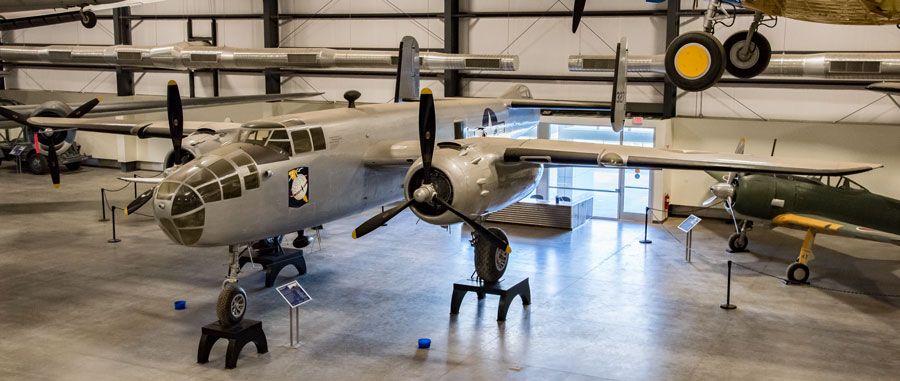North American B-25J Mitchell
The B-25 is perhaps the most successful American medium bomber of World War II. It served in every theater of the war, with all branches of the U.S. military and with several allied air forces. It is perhaps best known as the type of aircraft flown by the Doolittle Raiders from the aircraft carrier USS Hornet in early 1942. B-25s served as both traditional bombers and as gunships with large numbers of machine guns, and in one version a 75mm cannon in the nose. The B-25J returned to the standard “glass” nose for use as a bomber. However, many were converted to a “solid” gunship nose and used for very low level attacks. The Mitchell continued to serve in the U.S. Air Force until as late as 1960 as staff transports and trainers.
Service History:
Built by North American Aviation, Kansas City, Kansas and delivered to the USAAF on April 11, 1944.
Apr 1944 To Douglas Modification Center, Kansas City, Kansas for installation of combat equipment.
May 1944 To Hunter AAF, Georgia.
Jun 1944 To 11th Air Force, Elmendorf AAF, Alaska, via Great Falls AAF, Montana. Exactly what service this aircraft saw in Alaska is not clear. The 11th Air Force historian’s office indicates that it served with the 28th Bomb Group, 77th Bomb Squadron at Lexi Point Field on the island of Attu. However, other evidence including photographs and the memories of Major General Harry A. Johnson indicates that he appropriated the aircraft for use as his personal transport and that he retained the use of the aircraft for the remainder of his military career.
Wingspan | 67 ft 7 in. |
Length | 52 ft 11 in. |
Height | 16 ft 4 in. |
Weight | 35,000 lbs (loaded) |
Maximum Speed | 272 MPH |
Service Ceiling | 24,200 ft |
Range | 1,350 miles |
Engines | Two Wright R-2600-92 radials with 1,700 horsepower each |
Crew | 4-6 depending on mission |
Manufacturer
North American
Markings
11th Air Force, Elmendorf AAF, Alaska, 1945
Designation
B-25J
Serial Number
43-27712
Jul 1946 170th AAF Base Unit, Brooks AAF, San Antonio, Texas.
Feb 1947 Converted to TB-25J.
Jul 1947 To 366th AF Base Unit, Brooks AFB, Texas.
Jul 1948 2463rd Base Service Squadron, Offutt AFB, Nebraska.
Sep 1948 2466th Air Reserve Training Squadron, Stout AFB, Indiana.
Nov 1949 4406th Air Base Squadron, Marshall AFB, Kansas.
Dec 1949 Mobile Air Materiel Area, Brookley AFB, Alabama.
Mar 1950 56th Fighter-Interceptor Wing, Selfridge AFB, Michigan.
Sep 1950 10th Air Force Headquarters, Selfridge AFB, Michigan.
Apr 1955 Converted to TB-25N.
Dec 1957 2242nd Air Reserve Flying Center, Selfridge AFB, Michigan.
May 1958 Davis-Monthan AFB, Arizona for storage.
Aug 1960 Dropped from inventory by transfer to school or museum.
1972 Loaned to Pima Air & Space Museum by the National Museum of the United States Air Force.
